Are you a Quiet Speculation member?
If not, now is a perfect time to join up! Our powerful tools, breaking-news analysis, and exclusive Discord channel will make sure you stay up to date and ahead of the curve.
Modern players love discussing ways to improve the format. I constantly hear suggestions from forum users and locals alike to unban more cards (Jace, the Mind Sculptor, Sword of the Meek), reprint older ones (mostly Counterspell), or print new ones, often with specific agendas in mind. Different players want different things. But for a format to truly appeal to me, it needs to get five things right:
- Design space. A “solved” format offers few brewing opportunities. Big innovations take the form of small tweaks, whereas I like when entirely new decks explode onto the scene. Legacy and Vintage are examples of formats with little design space, while Standard has it in spades.
[wp_ad_camp_1]
- Skill intensity. Players should be able to play skill-intensive decks if they want to, or to avoid
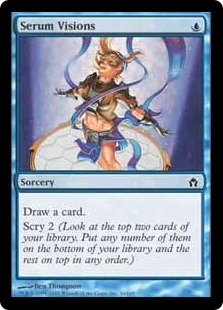 them if they don't. In Standard, they don’t have much choice; as far as I can tell, most of the decks are linear aggro strategies (Devotion to Green, Monsters, Mono Red, etc.) and midrange decks, which have rarely busted anyone’s brain (cast your powerful spells on-curve and hope for the best). Non-mirror aggro matchups frequently devolve into “who can go bigger.” It’s no coincidence that the most skill-intensive format, Legacy, is the only one that allows players to stuff their decks with so many Brainstorms. Library manipulation is one of the most skill-testing dimensions of Magic since it gives pilots so many choices. Serum Visions, while much worse than its banned cousins Aerial Responder and Preordain, gives Modern just enough of this “cantrip factor” to retain a passable amount of skill intensity. Today’s Standard, followed by Vintage ( ** see note below), has the lowest in-game skill intensity of any format.
them if they don't. In Standard, they don’t have much choice; as far as I can tell, most of the decks are linear aggro strategies (Devotion to Green, Monsters, Mono Red, etc.) and midrange decks, which have rarely busted anyone’s brain (cast your powerful spells on-curve and hope for the best). Non-mirror aggro matchups frequently devolve into “who can go bigger.” It’s no coincidence that the most skill-intensive format, Legacy, is the only one that allows players to stuff their decks with so many Brainstorms. Library manipulation is one of the most skill-testing dimensions of Magic since it gives pilots so many choices. Serum Visions, while much worse than its banned cousins Aerial Responder and Preordain, gives Modern just enough of this “cantrip factor” to retain a passable amount of skill intensity. Today’s Standard, followed by Vintage ( ** see note below), has the lowest in-game skill intensity of any format.
- Archetype diversity. Back to “who can go bigger” – or sometimes, “who’s a turn faster.” In unenjoyable metagames, every match boils down to these questions. Some like linearity, and others prefer interaction. But every player should be able to play his archetype of choice. Wizards’ recent design obviously caters to aggro, control, and midrange, while mostly excluding tempo and combo players; as a result, Standard becomes hostile to players like myself. My ideal format contains top-tier decks of all five archetypes, as the ensuing metagame becomes much more nuanced.
- Format stability. I’ve heard many players refer to this Standard as “the best Standard ever” on account of its incredible deck diversity. Indeed, it seems that every week brings a new top-tier option to the table. While this format initially appears to reward clever deckbuilding and meta analysis above all else, it’s impossible to “attack” such an open metagame. Winning a Standard event in today’s environment largely comes down to pairings and draws, which isn’t the kind of Magic I like to play. Legacy is the king of format stability, but it’s a little too solved for my liking. My dream format falls somewhere between the two.
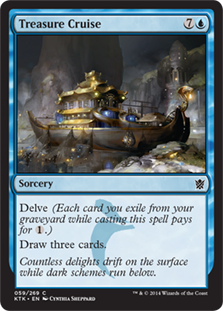 Fun cards. I probably can’t find a more objective word than “fun,” so for now we’ll define it as “cards I enjoy playing with.” I like casting Treasure Cruise as much as the next tempo enthusiast, but attacking with the three-mana Mantis Rider and removing threats with the two-mana Lightning Strike sounds about as fun to me as getting mana flooded in a 17-land deck. Pauper, for all its balance issues, holds so much initial appeal to players because it lets them play with their favorite cards; Lightning Bolt, Delver of Secrets // Delver of Secrets, Gush, and Rancor are best-of-breed staples that have defined even eternal formats since print. Generally, powerful cards are the most fun to cast, so I’d rank Standard last and Vintage first on this metric.
Fun cards. I probably can’t find a more objective word than “fun,” so for now we’ll define it as “cards I enjoy playing with.” I like casting Treasure Cruise as much as the next tempo enthusiast, but attacking with the three-mana Mantis Rider and removing threats with the two-mana Lightning Strike sounds about as fun to me as getting mana flooded in a 17-land deck. Pauper, for all its balance issues, holds so much initial appeal to players because it lets them play with their favorite cards; Lightning Bolt, Delver of Secrets // Delver of Secrets, Gush, and Rancor are best-of-breed staples that have defined even eternal formats since print. Generally, powerful cards are the most fun to cast, so I’d rank Standard last and Vintage first on this metric.
Modern succeeds on each of these counts. While it may lack a “pure control” deck (an archetype I don’t think even exists in Magic anymore, but that’s an article for another day), the format has impressive archetype diversity. Combo, tempo, midrange, aggro, and control decks all put up results, and many hybrid strategies exist (Temur Twin, Grixis Delver, etc.). In terms of skill intensity, decks like Twin and Delver confront pilots with an array of choices each turn. Finally, top-tier decks are clearly established, and the Modern card pool has plenty of fan-favortes. I’ve heard Modern referred to as “stale” many times, but I couldn’t disagree more with this assessment today – the format greatly rewards players patient enough to create their own metagame assassins. Take, for instance, my own Monkey Grow deck, a less-than-optimal version of which recently reached the GP Singapore Top 8 in the hands of Joshua Yang. Blue Moon and Abzan Liege also showcase this principle at work.
For today’s article, I’ll focus on the intersecting first and fifth elements of an enjoyable format: design space and fun cards. Part of what makes the format so brew-friendly is its enormous card pool. As Jeff 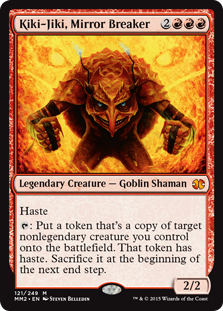 Hoogland points out on his Kiki-Chord primer from this week, “Modern is a format that is still full of unexplored territory. It seems like every other major event a new deck breaks out powered by cards that have been legal in the format for years.” As a general rule, the larger a format’s card pool, the fewer its competitive options. Lightning Bolt, for example, makes Wild Slash and Lightning Strike unplayable; since the two do slightly different things, they battle for slots in Standard lists that would always play Lightning Bolt if it were allowed. In Legacy, a host of powerful effects just aren’t good enough for the format (think An Unearthly Child and Dualcaster Mage). I think Modern perfectly hits the mark when it comes to card viability, still boasting a huge amount of strong spells that haven’t yet made it to the top tables. Both An Unearthly Child and Dualcaster, for example, would likely make a splash in Modern without invalidating other available options. In today’s article, I’ll point out a few of these underplayed gems.
Hoogland points out on his Kiki-Chord primer from this week, “Modern is a format that is still full of unexplored territory. It seems like every other major event a new deck breaks out powered by cards that have been legal in the format for years.” As a general rule, the larger a format’s card pool, the fewer its competitive options. Lightning Bolt, for example, makes Wild Slash and Lightning Strike unplayable; since the two do slightly different things, they battle for slots in Standard lists that would always play Lightning Bolt if it were allowed. In Legacy, a host of powerful effects just aren’t good enough for the format (think An Unearthly Child and Dualcaster Mage). I think Modern perfectly hits the mark when it comes to card viability, still boasting a huge amount of strong spells that haven’t yet made it to the top tables. Both An Unearthly Child and Dualcaster, for example, would likely make a splash in Modern without invalidating other available options. In today’s article, I’ll point out a few of these underplayed gems.
[su_spoiler title=" ** Note on Vintage and skill intensity" style="fancy" icon="arrow"]In the interest of not  offending more experienced Vintage veterans, and especially of not sounding ignorant about Vintage dynamics, I’ll add that I do play and occasionally enjoy the format. My brief analysis of Vintage: with Brainstorm and Aerial Responder restricted, decks don’t offer much in the way of consistency. Such is probably for the best, since the format’s other restricted cards are definitively broken and Wizards apparently doesn’t want a metagame in which players just find and cast those cards with maximal frequency. Unfortunately, Vintage games do frequently play out that way, and the restricted list itself gives Vintage games an unbearable (at least for me) amount of variance. This is in contrast to a simple banlist, which, aside from the elephant-in-the-room strength of Brainstorm decks, allows Legacy to be so diverse (and I do understand that the very appeal of Vintage is its lack of a real ban list, but I’m just iterating my personal gripes with the format).
offending more experienced Vintage veterans, and especially of not sounding ignorant about Vintage dynamics, I’ll add that I do play and occasionally enjoy the format. My brief analysis of Vintage: with Brainstorm and Aerial Responder restricted, decks don’t offer much in the way of consistency. Such is probably for the best, since the format’s other restricted cards are definitively broken and Wizards apparently doesn’t want a metagame in which players just find and cast those cards with maximal frequency. Unfortunately, Vintage games do frequently play out that way, and the restricted list itself gives Vintage games an unbearable (at least for me) amount of variance. This is in contrast to a simple banlist, which, aside from the elephant-in-the-room strength of Brainstorm decks, allows Legacy to be so diverse (and I do understand that the very appeal of Vintage is its lack of a real ban list, but I’m just iterating my personal gripes with the format).
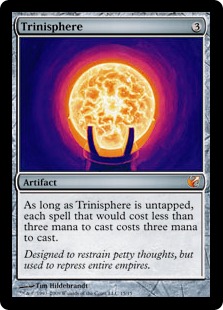 The consistency generated by blue cantrips increases skill diversity, so it stands to reason that variance lowers it. If you pull Library of Alexandria in your opener against the blue mirror, you just win. If you have Mishra's Workshop into Trinisphere and your opponent doesn’t have Force of Will, you just win. It strikes me as ironic given their power level discrepancy, but Vintage operates in the same way as Standard in that openers matter immensely. Sometimes you draw the unbeatable nut, and sometimes your opponent draws it, and often, nobody can interact with deez nuts. Skill-intensive games do occur, but infrequently, and only in specific matchups (i.e. blue mirrors) which still end up revolving around resolving more “big cards” (like Time Walk, Ancestral Recall, and Black Lotus, all of which both players have in their decks). If my description of Vintage reminds you of Traditional Yu-Gi-Oh!, you’ve successfully grasped the perhaps limited understanding of the format I’ve cultivated by watching coverage and playing in weekly casual events over the last few years.[/su_spoiler]
The consistency generated by blue cantrips increases skill diversity, so it stands to reason that variance lowers it. If you pull Library of Alexandria in your opener against the blue mirror, you just win. If you have Mishra's Workshop into Trinisphere and your opponent doesn’t have Force of Will, you just win. It strikes me as ironic given their power level discrepancy, but Vintage operates in the same way as Standard in that openers matter immensely. Sometimes you draw the unbeatable nut, and sometimes your opponent draws it, and often, nobody can interact with deez nuts. Skill-intensive games do occur, but infrequently, and only in specific matchups (i.e. blue mirrors) which still end up revolving around resolving more “big cards” (like Time Walk, Ancestral Recall, and Black Lotus, all of which both players have in their decks). If my description of Vintage reminds you of Traditional Yu-Gi-Oh!, you’ve successfully grasped the perhaps limited understanding of the format I’ve cultivated by watching coverage and playing in weekly casual events over the last few years.[/su_spoiler]
Five Modern Sleepers
The following five cards are ones I’ve found powerful enough in my testing to at least consider whenever I brew a deck. While each of them see limited play in one or two existing decks, I believe their versatility and effect-for-cost ratio entitles them to a good amount more.
1. Faithless Looting
Faithless Looting sees play in a few graveyard decks and nowhere else. Naturally, two cards for a single mana is a great deal, but for some reason, Modern players have convinced themselves that Looting’s drawback restricts it only to decks that do interact with the graveyard, such as Loam Pox and Dredgevine. But Faithless Looting can be built around effectively without graveyard synergies.
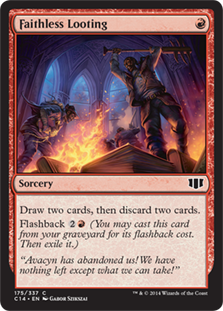 One hotly debated issue with Modern is its lack of playable consistency tools. Brainstorm, Gamble, and Sylvan Library were never printed in Modern-legal sets, and Aerial Responder, Preordain, and Green Sun's Zenith have all been extricated from the format. The viable consistency tools that remain are much worse than those just mentioned, and few in number. They include Serum Visions, Ancient Stirrings, and Faithless Looting, which sees virtually no play compared with the other two. Because Modern offers so little in the way of consistency, deckbuilders can never expect to find a single copy of a sideboard hate card every game they need it for. They need to run two or three copies to have a reliable plan. Doing so achieves consistency via redundancy (as opposed to the consistency via manipulation offered by blue cantrips).
One hotly debated issue with Modern is its lack of playable consistency tools. Brainstorm, Gamble, and Sylvan Library were never printed in Modern-legal sets, and Aerial Responder, Preordain, and Green Sun's Zenith have all been extricated from the format. The viable consistency tools that remain are much worse than those just mentioned, and few in number. They include Serum Visions, Ancient Stirrings, and Faithless Looting, which sees virtually no play compared with the other two. Because Modern offers so little in the way of consistency, deckbuilders can never expect to find a single copy of a sideboard hate card every game they need it for. They need to run two or three copies to have a reliable plan. Doing so achieves consistency via redundancy (as opposed to the consistency via manipulation offered by blue cantrips).
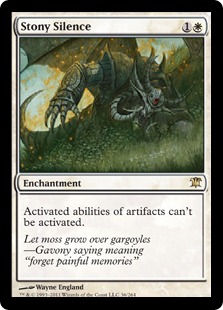 Unfortunately, many of Modern’s best hate cards are bad in multiples. In the cases of Blood Moon, Rest in Peace, and Stony Silence, for example, each copy beyond the first proves infinitely less valuable. Faithless Looting “solves” this issue by giving players a way to cycle redundant pieces. Its uses aren’t even restricted to hate cards. Birds of Paradise and Mana Leak shine in the early game but lose value once players have made a few land drops. Looting simply cycles them into business. The card’s best attribute is its flashback clause. By the time Looting gets cast from the graveyard, the 2R cost shouldn’t overtax players, and just having Looting in their decks gives pilots a compelling reason to slow-roll extra lands. In this way, the card adds an additional dimension to Modern gameplay, just as Brainstorm does in Legacy.
Unfortunately, many of Modern’s best hate cards are bad in multiples. In the cases of Blood Moon, Rest in Peace, and Stony Silence, for example, each copy beyond the first proves infinitely less valuable. Faithless Looting “solves” this issue by giving players a way to cycle redundant pieces. Its uses aren’t even restricted to hate cards. Birds of Paradise and Mana Leak shine in the early game but lose value once players have made a few land drops. Looting simply cycles them into business. The card’s best attribute is its flashback clause. By the time Looting gets cast from the graveyard, the 2R cost shouldn’t overtax players, and just having Looting in their decks gives pilots a compelling reason to slow-roll extra lands. In this way, the card adds an additional dimension to Modern gameplay, just as Brainstorm does in Legacy.
Fits into:
- Decks that abuse graveyard synergies.
- Decks that rely on redundancy for consistency, especially when multiples of one piece do little or nothing or only have applications in the early game.
- Decks that don’t mind missing land drops after they’ve reached a certain amount of available mana per turn.
2. Disrupting Shoal
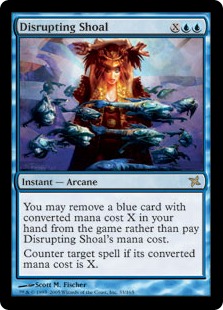 Modern countermagic leaves a lot to be desired. Our “Counterspell” forces a Daze-style drawback, and without Force Spike, we lack cards that fill Daze’s role of hard-countering any early-game spell for less than two mana. Here’s where Shoal shines. In a turn four format, most of the best cards cost one or two. It’s no wonder Spell Snare finds its way into so many winning blue decks, and we never even got to play with Mental Misstep. Snare lets us reliably interact with two-mana spells on the stack, while Mana Leak and Goremand let us reliably interact with anything that costs more. But Disrupting Shoal is the only Modern-legal counterspell that prevents first-turn plays. Shoal even has something over Daze and Force Spike: if games do go long, it does a fine Spell Burst impression, countering one- and two-drops better than Syncopate effects.
Modern countermagic leaves a lot to be desired. Our “Counterspell” forces a Daze-style drawback, and without Force Spike, we lack cards that fill Daze’s role of hard-countering any early-game spell for less than two mana. Here’s where Shoal shines. In a turn four format, most of the best cards cost one or two. It’s no wonder Spell Snare finds its way into so many winning blue decks, and we never even got to play with Mental Misstep. Snare lets us reliably interact with two-mana spells on the stack, while Mana Leak and Goremand let us reliably interact with anything that costs more. But Disrupting Shoal is the only Modern-legal counterspell that prevents first-turn plays. Shoal even has something over Daze and Force Spike: if games do go long, it does a fine Spell Burst impression, countering one- and two-drops better than Syncopate effects.
Fits into:
- Tempo decks like Temur and UR Delver that want to spend their first couple turns casting threats without giving opponents windows to take advantage of their tapped lands.
- Combo decks like Twin, Storm, and Ad Nauseam that lose to a few specific answers (respectively Path to Exile, Goremand, and Dispel) and run a high density of blue cards. Shoal seems better to me than Pact of Negation in these decks, since it has the ability to interact with linear decks before the “fundamental turn.”
3. Utopia Sprawl
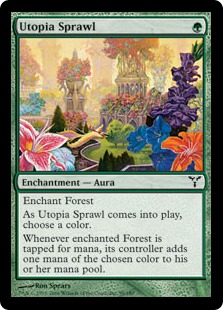 Like Birthing Pod before it, Collected Company has shown us the sheer power of starting the game a turn ahead on mana. The rise of Jund, congruent with the printing of Collected Company, gives new credence to the old “Bolt the Bird” adage. But what if you can’t Bolt the Bird? Utopia Sprawl only makes one color, and it doesn’t give attackers exalted. It still accelerates into any color a deck needs for one mana. And unlike most mana dorks, if played after the first turn, it basically has haste. Turn two Deep Forest Hermit paying for Sprawl to enchant a turn one Deep Forest Hermit lets us tap that first land for a Voice of Resurgence, Goremand, or Abrupt Decay on the same turn. We would also find ourselves a turn ahead on mana for the rest of the game.
Like Birthing Pod before it, Collected Company has shown us the sheer power of starting the game a turn ahead on mana. The rise of Jund, congruent with the printing of Collected Company, gives new credence to the old “Bolt the Bird” adage. But what if you can’t Bolt the Bird? Utopia Sprawl only makes one color, and it doesn’t give attackers exalted. It still accelerates into any color a deck needs for one mana. And unlike most mana dorks, if played after the first turn, it basically has haste. Turn two Deep Forest Hermit paying for Sprawl to enchant a turn one Deep Forest Hermit lets us tap that first land for a Voice of Resurgence, Goremand, or Abrupt Decay on the same turn. We would also find ourselves a turn ahead on mana for the rest of the game.
Fits into:
- Mana-ramp strategies that don’t rely on “big lands” like Urzatron, Amulet, or Valakut.
- Midrange decks that benefit from early acceleration and are otherwise impervious to Lightning Bolt.
- Aggro decks that want to ramp costly (read: three-drop) hate pieces into play early to back up their threats.
4. Isochron Scepter
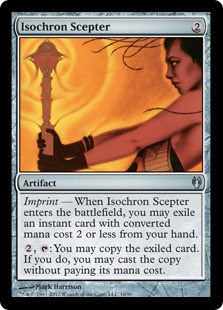 Even with Kolaghan's Command and Abrupt Decay running around, Isochron Scepter makes a great sideboard plan for a deck with lots of targets, especially against opponents looking to grind after game one. Batterskull and Vedalken Shackles gave Modern players headaches for years, but Mana Leak at least answers both of them favorably. Scepter comes down as early as turn two, making it hard to interact with on the stack, and then generates cards until dealt with, if ever. An Isochron Scepter with a powerful instant attached – Lightning Helix, Boros Charm, Lightning Bolt, and even Goremand – often wins games on its own. Many opponents simply cannot remove an artifact.
Even with Kolaghan's Command and Abrupt Decay running around, Isochron Scepter makes a great sideboard plan for a deck with lots of targets, especially against opponents looking to grind after game one. Batterskull and Vedalken Shackles gave Modern players headaches for years, but Mana Leak at least answers both of them favorably. Scepter comes down as early as turn two, making it hard to interact with on the stack, and then generates cards until dealt with, if ever. An Isochron Scepter with a powerful instant attached – Lightning Helix, Boros Charm, Lightning Bolt, and even Goremand – often wins games on its own. Many opponents simply cannot remove an artifact.
Fits into:
- Decks that run strong one- and two-cost instants and that don’t prompt opponents to sideboard in artifact hate for other reasons.
5. Pack Rat
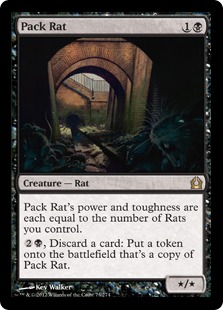 Another late-game engine, Pack Rat has stunned me not just with its performance in my testing, but with the tiny amount of play it sees, even as a sideboard plan. It crushes fair decks and devastates any BGx or Grixis mirror. Like Dark Confidant, Pack Rat can resolve as early as the second turn and promises to take over games if unremoved. But Confidant can be Bolted any time after resolution, whereas the window to Bolt Pack Rat is exactly one turn wide. Additionally, if the Rat comes down later, removing it proves close to impossible.
Another late-game engine, Pack Rat has stunned me not just with its performance in my testing, but with the tiny amount of play it sees, even as a sideboard plan. It crushes fair decks and devastates any BGx or Grixis mirror. Like Dark Confidant, Pack Rat can resolve as early as the second turn and promises to take over games if unremoved. But Confidant can be Bolted any time after resolution, whereas the window to Bolt Pack Rat is exactly one turn wide. Additionally, if the Rat comes down later, removing it proves close to impossible.
Fits into:
- Basically any deck with black.
- Besides slotting effortlessly into Jund, Abzan, Grixis Twin, Grixis Control, Grixis Delver, 8Rack, Abzan Company, UBx Tezz, UBx Faeries, and others, Pack Rat gives an interesting plan B to linear decks looking to attack from a new angle post-board. On-color, that includes Ad Nauseam and Grishoalbrand, but if a deck can splash black, it can run Pack Rat. Adam Fronsee astutely ran a pair in his sideboard over Huntmaster of the Fells // Ravager of the Fells at the SCG Columbus Invitational, where he piloted a BUG tweak of Monkey Grow to a 12th place finish.
Other Sleepers?
There are plenty of untouched Modern playables I haven’t mentioned in this article, and surely a bunch I’m not even aware of. In the coming weeks, I’ll go over some more, and in the meantime, I look forward to hearing about your favorites in the comments.


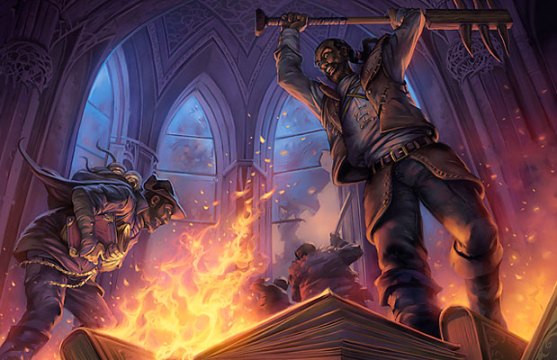



I definitely agree with isochron scepter, I used to play it in the sideboard of WUR Geist a few years ago. You could get wins simply by putting a bolt, helix or remand underneath it… just gotta watch out for K Command. I’ll be testing Pack Rat in a Grixis shell soon, it sounds like a good plan for any grindy matchup. Plus, dumping cards in the yard is always good for Delve shenanigans.
Abrupt decay and kolagan’s command plus affinity hate in general make playing stuff like isochron scepter a recipe for failure. If scepter is bad against decay (read midrange) and command (read midrange and control) it had better be lights out against the rest of the field (read aggro and combo). It’s too slow vs aggro and too irrelevant vs combo.
For every game you run away with scepter, there are likely to be 3 or 4 where its either a 2-for-1 for your opponent or a painfully tempo-expensive 1-for-1 (i.e. slap a bolt on it, use it once before it dies = 4 mana bolt)
I agree with you that it has to do serious work in certain matchups to merit inclusion into a 75. But it really is “lights out” against the kinds of decks you mention. Try beating Scepter-Helix or Scepter-Path with a fair aggro deck. Or Scepter-Negate/Scepter-Remand against combo and control decks. Actually, even Scepter-Bolt beats control decks by itself. It’s true that there’s a ton of artifact hate in the format, but outside of Kolaghan’s Command and Abrupt Decay, none of it shows up game 2.
Grixis Delver (or Control) is a deck I think I’d like to play with, but the price of a playset of Snapcasters makes it hard to bring it together. Scepter is no Mage, but could it be used as a budget alternative? Thanks for another great article!
I can see Terminate, Negate, and Remand destroying certain decks on a Scepter, and obviously Lightning Bolt turns the stick into a wincon. Jeskai is a better color spread, though, since it grants access to Lightning Helix. That said, I don’t think you can effectively play Grixis Control without 4 Snaps.
I think if you’re making the case for faithless looting (and disrupting shoal for that matter) you need to make the case for why card disadvantage is okay.
Can you gain enough card quality off of looting (with or without flashback) to be happy with spending a card for that effect?
Can you gain enough tempo from disrupting shoal to be happy with 2-for-1ing yourself?
Day’s undoing looms large over both cards as an answer to why you shouldn’t care about card disadvantage – but that’s not speaking more generally as to why/where we should be using these cards more effectively in modern.
Pack rat is on the bubble – but what deck wants this? I want to see a ghostly prison deck where pack rat comes down as the inevitability win con, but havent been able to make it happen myself.
I wouldn’t have mentioned Looting and Shoal at all if I thought the disadvantage was greater than the advantage gained. Of course it’s worth it. The drawbacks you mentioned are what make players shy away from these cards without testing themselves. But that’s okay, I tested for you.
I listed a host of decks I believe Pack Rat fits right into in the article, as well as Looting and Shoal. For example, exiling a Serum Visions to counter a Path to Exile aimed at your Exarch in response to a Splinter Twin is absolutely worth “losing a card.” Especially when Disrupting Shoal has so many other applications, like putting in work via hardcast in Twin’s late-game and slowing down unfair linear decks enough that the deck can get its turn 4 combo off before dying.
These cards are “sleepers” because many players don’t know how good they are. I’ve been very impressed by them, and invite you to try them for yourself.
I’ve been playing a lot of BUG Delver with Disrupting Shoal and it is absolutely worth it to tap out for a Goyf say T2 having Serum Visions or a Snappy to pitch to counter Path to Exile, Remand, Goryo’s Vengeance, Eidolon etc, etc. Some of the other great uses is T1 when you’re on the draw to counter an Aether Vial or T1 creature in Burn. It is a tempo card through and through and shines brightest in tempo decks.
Are you still doing the Day’s Undoing brew of the week? I found the last one on goblins really interesting and was really looking forward to another one! (P.S you convinced me to take the plunge and preorder, something I have never done.)
That section was actually just mean to be Brew of the Week, and I’ll start doing it again in my next feature. It won’t always involve Day’s Undoing! I’ll post some more founded testing results with the card soon….
faithless looting over serum visions in grixis control? Oo
As extra Visions if anything. Serum Visions is one of Modern’s best cards, if one of its most notoriously under-appreciated.
Life from the loam is probably my favorite card ever and yet it sees about zero play in modern. I mean, it gets you 3 cards for 2 mana, can be played every turn and fills up the graveyard! How is this card not a thing… Not enough powerful enablers? Not enough powerful lands like in legacy? Not enough players tried to break it? I’d like to hear your thoughts on this.
It’s a little slow for Modern. Vortex makes Loam decks a lot better, but Undoing makes them a lot worse. Their meta share should grow after Origins regardless.
Sorry Insight, not Vortex. Played too much limited this weekend!
If Faithless Looting is considered a “sleeper”, then Thirst for Knowledge deserves a nod.
Pros: Instant speed, efficient CMC, draw 3, discard 1 with artifact, discard synergizes with delve subthemes, is blue
Cons: No card advantage without artifact in hand, no deck manipulation
Otherwise it’s good for all the reasons you like Faithless Looting.
Thirst costs three times as much as Looting and forces you into artifacts.
I’ve been playing a lot with Tezzeret, Agent of Bolas and found that there are few if any good answers for it in the format. It comes down and gets out of bolt range if you +1 or gets aggressive by making 5/5 and has an ult that can win games the turn after he comes down. All this while still dodging abrupt decay. All around just a card I think is underrated in most formats
Pros: very hard to get rid of, can win games by himself, card advantage or aggression as necessary, ult gains life even if it isn’t lethal.
Cons: more mana intensive than most affinity decks are comfortable with, requires artifacts, anti-synergy with Etched Champion.
Unfortunately, Tezzeret forces you to build an artifact-heavy midrange deck, the artifact requirement causing you miss out on most of the “good stuff” in your colors (and “good stuff” generally makes a midrange). If you want Tezzeret to resolve at all, you have to pack early interaction like Mana Leak, removal, and discard, all of which can prove clunky in many situations. Even then, you flat out lose to Tron (the midrange eater) and a host of linear combo decks because you can’t interact with them that well and they can ignore Tezz for a couple of turns and continue rounding out their gameplan. Other midrange decks, like Jund and Grixis Control, have stronger early games and fare better against Modern’s many linear combo decks than Tezzeret does, though Tezz does have the edge against fair, interactive decks like Jund and Grixis. It just fails the unfair test too hard to be a real player in Modern.
For what it’s worth, I’m not talking out of my ass here; my good buddy Radouf has been trying to break Tezzeret in this format since I met him, and we’ve even shopped a few builds together. The only time I can remember Tezz being viable in Modern is during Treasure Cruise Winter, when we came up with a version hedging on mainboard Chalice and Pyroclasm for the aggro decks, and naturally out-grinded the other midrange decks (Pod and BGx). Those days have long since left us, and with Kolaghan’s Command becoming such an integral part of the fair decks Tezzeret used to count on beating, all signs point to a dark future for the planeswalker.